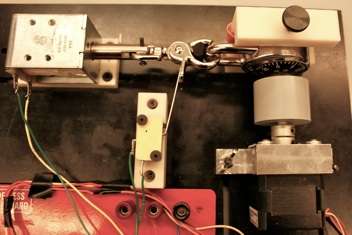March 10, 2011 weblog
Engineering students design a lock picking robot

(PhysOrg.com) -- Crimes are usually committed by humans. As it turns out, we are not only making crime happen on our own, but we are designing robots to help us in our extra-legal endeavors. I don't know what the students at the Olin College of Engineering are up to in their spare time, but they have taken the time to design a robot that picks locks for them. This robot can not only pick a lock, but it can find the combination to any Masterlock lock in under two hours, without resorting to a chisel and hammer. If you have one number things will go much quicker. You won't get to class in time, but you can do a stealthy pilfering with it, if you have at least half an hour of uninterrupted time to work with.
The robot is surprisingly simple in its design. It all starts with a clamp that is designed to hold the lock in its place. The combination of a thumb-screw, a puller, and a solenoid-controlled grabber then proceed to yank the loop of the lock and give a shot at opening the lock. If this first step is not successful a stepper-motor will engage, turning the knob and dials in various combination's until it finds the correct one. This hardware, combined with companion software that is known as LockCracker, will keep an eye on what works and what does not. When it finds the correct combination it will actually display the code for future use.
For now the device it too big to be used by home invaders, so you will not have to deal with it in the near future. No commercial applications have been given at this time, and the device is not expected to go on sale.
More information: students.olin.edu/2013/jnoglow … ker/The_Project.html
© 2010 PhysOrg.com
















